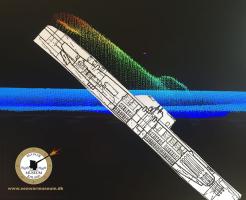 The Sea War Museum Jutland made an amazing discovery while scanning the sea floor off Denmark. They have identified the wreckage of one of the most technologically advanced German submarines of World War II, the U-3523. The submarine was found with its bow buried in the mud and its stern rising from the seafloor in 123 meters of water, ten nautical miles north of Skagen.
The Sea War Museum Jutland made an amazing discovery while scanning the sea floor off Denmark. They have identified the wreckage of one of the most technologically advanced German submarines of World War II, the U-3523. The submarine was found with its bow buried in the mud and its stern rising from the seafloor in 123 meters of water, ten nautical miles north of Skagen.
The U-3523 was a Type XXI submarine and was the most advanced submarine of its time, capable of operating underwater almost indefinitely, relying on large battery banks which could be recharged by snorkel. The hulls were streamlined and more hydrodynamically efficient than other submarines of the period. They could also use hydrogen peroxide as a fuel and were capable of operating at up to 17 knots submerged for short periods.
Between 1943 and 1945, 118 Type XXI submarines were under construction by German shipyards, but only four were finished and only two ever put to sea. The U-3523 was sunk by a British B24 Liberator bomber on May 6, 1945, the day after Allied forces liberated Denmark from Nazi occupation.
Captured Type XXI submarines greatly influenced post-war submarine design. The only surviving Type XXI is on display at the German Maritime Museum at Bremerhaven, the base for a large part of the German submarine fleet during the Second World War.

Nonsense! The type XXI U boat never used hydrogen peroxide as a fuel, this substance was simply too unstable and dangerous! Yes, two did see a war patrol but I believe that more than 4 were completed before the war ended. A number were sunk during their sea trials either by aircraft or mines while others were scuttled by their crews at the war’s end.
The type XXI was the basis for the Russian Whisky class, the French Daphne class and also the Swedish Nordkaperen class subs. The hull of the U.S. Navy’s first nuclear sub, the Nautilus was influenced by the class XXI.